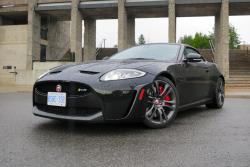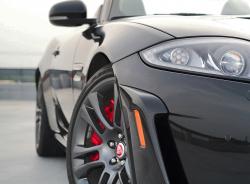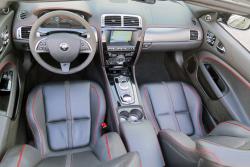Once upon a time, the name “Jaguar” would summon up visions of genteel British exclusivity – of tweed-clad squires, drawing rooms panelled with ancestral paintings, Meershaum pipes, and faithful hounds at foot on faded Aubusson rugs.
A rich legacy established by luxurious saloons, racetrack victories and sleek, sexy roadsters, had for decades made Jaguar a symbol of affluence for wealthy Brits. Sports cars like the E-type cemented Jaguar’s reputation for gorgeous design, and owners prized them for the elite, yet sensuous image they projected.
And yet, in the years leading up to the new millennium, Jaguar seemed to lose its focus and its vehicles had become frumpy and dated. A decade of ownership by Ford, with an estimated injection of $50 billion in funds, failed to revive the brand, and in 2008, it was purchased by Tata Motors. There’s a certain poetic irony in a company from India coming to the rescue of one of the British Empire’s most storied and venerable marques – and yet Jaguar has made a remarkable turnaround under their leadership. Both the XK coupe and XF saloon have been dazzling sales successes, and more importantly, have restored a sense of desirability to the Jaguar brand that has been lacking in recent years.
The F-Type Coupe lit up the automotive landscape with all the ferocity of a comet blazing across a summer night sky – banishing any lingering vestiges of frumpiness to some dark archival closet. While its styling cues have obviously been influenced by the iconic E-Type, the F-Type injects the brand with a fresh, new sexiness.
Unfortunately, the F-Type’s popularity has come at the expense of the XK, whose sales have tanked since the launch of the smaller, more flamboyant, and less expensive two-seater. While some claim that the XK is stale and dated by comparison, and the F-Type a more worthy successor, we disagree.
The new F-Type is indeed a stupendous new addition to the Jaguar lineup. But the brash little sports car fills a different niche than the lovely XK, which is at heart, a grand tourer.
My tester for one glorious week was a slinky topless XKR-S, a veritable black panther of a machine. Long and lithe, it’s no surprise that the XK was penned by designer Ian Callum – its resemblance to his achingly beautiful Aston Martin DB7 is unmistakable.
   2014 Jaguar XKR-S, dashboard. Click image to enlarge |
A beautiful, flowing, organic shape, the XK features aluminum skin stretched taut over fluid curves, and like its E-type ancestor features a long, elegant nose and abbreviated deck atop coiled haunches.
The XKR-S was top dog (or should that be top cat?) of the lineup until the recent addition of the XKR-S GT – an all-out, track-ready derivative boasting carbon-ceramic brakes and tweaked suspension components. This beefed-up version of the XK features several aerodynamic cues that set it apart from the ordinary XK.
The wide stance is accentuated by meaty 20-inch gunmetal-grey alloys through which peep red calipers – a quick glimpse of naughty underthings. Nostrils on either side of the long, aquiline nose deliver fresh, cool air to the supercharged 5.0-litre engine within. A sharply carved front air splitter framed with a carbon-fibre chin spoiler lend a snarling, belligerent air to the XKR-S’s expression. Stylish vents on both flanks help cool down the brakes.
Its muscular hindquarters already give the XKR-S the air of stored motion, coiled and ready to pounce. They’re finished off with a rear diffuser, and topped with carbon-fibre rear wing that generated a few mixed opinions.
The cabin boasts all the requisite attention to detail expected from a premium marque, from the aluminum trim to the carbon leather accents. Exclusive to the XKR-S model is a suede-wrapped steering wheel, contrasting red stitching on all leather upholstery – including the dash and gauge binnacle, and RS badging scattered throughout the cabin.
   2014 Jaguar XKR-S seating. Click image to enlarge |
Highly bolstered bucket seats are plump and comforting and can go from gentle embrace to iron-fisted grip at the twist of a button – just the thing for spirited cornering. While the XKR-S is considered a 2+2, those beautifully sculpted rear seats are virtually useless for anyone with legs. Compared with the coupe’s 330 litres, the convertible offers 313 litres of “boot” space.
The XKR-S comes equipped with all the technological bells and whistles you’d expect from this segment; a touchscreen interface for audio, navigation, climate control and phone connection. Compared to other available systems, it’s a little convoluted and could use some streamlining. While I’ve gotten used to the rotary gear selector that rises from the centre console at startup, it still seems a little gimmicky.
From a purely visual aspect, I’ve always preferred a coupe over a convertible. A hard top looks cohesive, while a rag top interrupts the smooth flow of line moving up and over the body of the car. However, the roof tucks away neatly – in 18 seconds no less – appeasing most of the remaining senses. Aside from the usual reasons for drop-top love – feeling the warm sun upon your face while summer breezes ruffle your hair, and all that rot – is the aurally gratifying sense of having nothing between you and that incredible exhaust note. At idle, the XKR-S produces a soft, velvety rumble. But dial in the Sport setting, head for the nearest tunnel, and try not to giggle at the booming roar echoing around you. Let off the throttle and the quad pipes erupt in outrageous pops and barks.
   2014 Jaguar XKR-S. Click image to enlarge |
Under its long nose is a more powerful version of the supercharged 5.0-litre engine found in the regular XK, producing 550 horsepower and 502 lb-ft of torque. That power is run through a six-speed ZF transmission that does a fine job of ripping through the gears, but there are aluminum paddle shifters should you want that decision to be yours.
Available from 2,500 to 5,500 rpm, the torque is enough to slam you back into the seat. With a top speed of 300 km/h and 0–100 time of 4.4 seconds, it’s laughably easy to find yourself in big-ticket territory when pulling out to pass. Disrespecting this car is not a wise idea, as it’s not as forgiving as either the R8 Spyder or 911 Turbo S Cabrio. A foolhardy tromping of the pedal could reward you with a rear end slide when the electronic differential delivers all of the torque to the rear wheels during hard acceleration. It’s particularly squirmy on wet pavement. Choosing Sport mode not only quickens up throttle and transmission response, it triggers the adaptive suspension to lower the car by 10 mm.
Jaguar’s done a fine job of alleviating any of the typical flex inherent in most convertibles – the car feels as stiff as any of the XK coupes I’ve previously driven. Revised springs are some 28 percent stiffer than the regular XK’s, but the adaptive suspension keeps the ride supple and compliant.
While the steering isn’t as reassuringly solid as the Porsche’s, it’s sharp, accurate and the suede-wrapped wheel feels great in the hands.
   2014 Jaguar XKR-S, wheel detail, paddle shifter. Click image to enlarge |
Official fuel consumption numbers are 14.2 L/100 km city/9.2 – exactly the same as the regular XK. Over a week of admittedly “spirited” driving, I averaged 13.6 L/100 km.
The Jaguar XKR-S is certainly not my first choice for a track car – it’s a bloody handful when pushed to the limit. But as an outrageously gorgeous grand tourer, it has few equals.
There are a few rare cars that, through a mysterious sort of alchemy, become more than the sum of their parts – transcending their constructions of metal, rubber and glass, almost seeming alive. There are a few in its segment that offer just as much luxury and equal or greater power. But few deliver that sense of occasion that is the essence of Jaguar. A drive made even more special in knowing it’s probably the last – the XK is expected to be discontinued after 2015.
Pity.
|
Manufacturer’s Website: Jaguar Canada Photo Gallery: Crash Test Results: |
Pricing: 2014 Jaguar XKR-S Convertible
Base price: $146,000
Options: Carbon Fibre Exterior Pack ($1600), Heated front windshield ($425), Carbon Fibre engine cover ($2300)
Destination: $1350
Price as tested: $149,900
Competitors:
Audi R8 Spyder
Mercedes Benz SLS AMG Convertible
Porsche 911 Turbo S Cabriolet


















